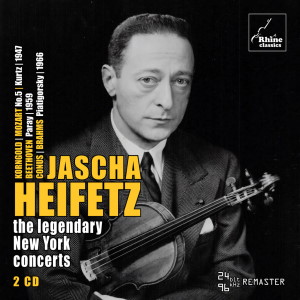
Jascha Heifetz (violin)
The Legendary New York Concerts
Erich Wolfgang Korngold (1897-1957)
Violin Concerto in D major, Op.35 (1945)
Wolfgang Amadeus Mozart (1756-1791)
Violin Concerto No.5 in A major, K.219 Turkish (1775)
Jules Conus (1869-1942)
Violin Concerto in E minor, Op.1 (1896)
Ludwig van Beethoven (1770-1827)
Violin Concerto in D major, Op.61 (1806)
Johannes Brahms (1833-1897)
Double Concerto for violin and cello in A minor, Op.102 (1887)
Gregor Piatigorsky (cello)
New York Philharmonic-Symphony Orchestra/Efrem Kurtz (Korngold, Mozart)
Unnamed orchestra without conductor (Conus, Brahms)
Detroit Symphony Orchestra/Paul Paray (Beethoven)
rec. 30 March 1947, Carnegie Hall (Korngold, Mozart); 15 October 1966, Carnegie Hall (Conus, Brahms); 9 December 1959, UN General Assembly Hall, New York (Beethoven)
RHINE CLASSICS RH-025 [67 + 71]
I first encountered the performances of the Korngold and Mozart No. 5 Concertos from Carnegie Hall, 30 March 1947 with the New York Philharmonic-Symphony Orchestra under the baton of Efrem Kurtz on a Rococo LP (RR-2074) about thirty years ago. They’ve also made it to silver disc on a release issued by Pristine Audio (PASC513). That release has been reviewed in these pages but, unfortunately, I haven’t heard that transfer to offer any comparisons. Rhine Classics’ 24bit 96 kHz remastering is definitely a sonic improvement on my old LP, though. The Korngold is prefaced by an announcement, where we are informed that Heifetz had premiered the Concerto with the St. Louis Symphony Orchestra conducted by Vladimir Golschmann on 15 February 1947. This March 1947 airing is its first radio performance, with Korngold himself present in the audience. Heifetz was to make a commercial recording of the work on 10 January 1953 with the Los Angeles Philharmonic under the direction of Alfred Wallenstein. This live performance is compelling, and an ideal balance is struck between orchestra and soloist. Needless to say, Heifetz is on absolutely top form and his immaculate delivery is breathtaking. His silken tone and ravishing colours shine through at every stage. There’s striking contrasts made between the melancholic sojourns and the more rakish elements of the work. Kurtz is a wonderful conductor, offering sensitive and sympathetic support all the way.
The Mozart Concerto is equally endearing. Heifetz made three commercial recordings of this Concerto, in 1934 with John Barbirolli, in 1951 with Sir Malcolm Sargent and in 1963 with a chamber orchestra under his own direction. There isn’t much interpretive diversion between all the recorded performances; Heifetz was a very consistent player, and once he settled on an interpretation he usually stuck with it. In this live inscription the playing is fresh and spontaneous, with heartfelt tenderness suffusing the slow movement. I particularly like the Turkish section in the finale which is more highly charged than most I’ve heard.
The Beethoven Concerto performance was given on 9 December 1959 at the UN General Assembly Hall in New York. The orchestra is the Detroit Symphony, the conductor Paul Paray. I recall a photo in Herbert Axelrod’s book on the artist showing Heifetz walking onto the stage using a cane. Apparently he’d broken his hip several months earlier but, like the trooper he was, he delivered an outstanding performance. He uses the Auer cadenza, which he’s slightly tweaked. Brisk tempi are favoured throughout, yes, even in the slow movement. Paray is a masterful conductor, and provides orchestral support of streamlined precision. The sound quality is agreeable.
“Given the great historical value and despite non-professional sound quality, we decided to release anyway this 1966 private recording”. Thus, Rhine Classics introduces two bonus tracks, taped from the audience, of a live concert given at Carnegie Hall on 15 October 1966. The two works performed are the Conus Violin Concerto and the Brahms Double Concerto in which Heifetz is partnered by Gregor Piatigorski. The concert also featured the cellist in Haydn’s D major Concerto, but it’s not included here. The orchestra is a pick-up ensemble led by John Corigliano, newly retired from the New York Philharmonic. The performances are marked as without a conductor. There’s a New York Times review by Howard Klein printed in the booklet. The Conus gets the enthusiastic thumbs up, with especial praise for the spiccato in the last movement. Klein isn’t as positive about the Brahms, quite rightly pointing out that the lack of a conductor rendered some of the ensemble wayward. There’s also some disagreement between the two soloists as to tempo; Heifetz constantly pushes forward. I should also mention that the sound is far from ideal. In the Conus, especially, the violin sounds very faint and recessed. Fortunately, Heifetz made a studio recording of this wonderful Concerto in 1952 with Izler Solomon and the RCA Victor Symphony Orchestra which, incidentally, is Itzhak Perlman’s favorite Heifetz recording.
All told, this is a very desirable release. The booklet contains some excellent notes by Gary Lemco, and a few fascinating photos of the artist. Heifetz fans, of which I’m one, shouldn’t hesitate.
Stephen Greenbank
Previous review: Jonathan Woolf
Availability: Rhine Classics


















